Intel launched the SSD 530 series as a progressive update on their SSD 520 line, moving away from the 25nm NAND flash and incorporating new SandForce silicon with 20nm flash for more efficient power consumption. The 530 series also consolidates Intel's various form factors which previously carried different model numbers.14 new products don the SSD 530 brand in a variety of different form factors; standard 2.5", mSATA and M.2. As was the case with their previous series, Intel has optimized the SandForce firmware to deliver a combination of performance and reliability.
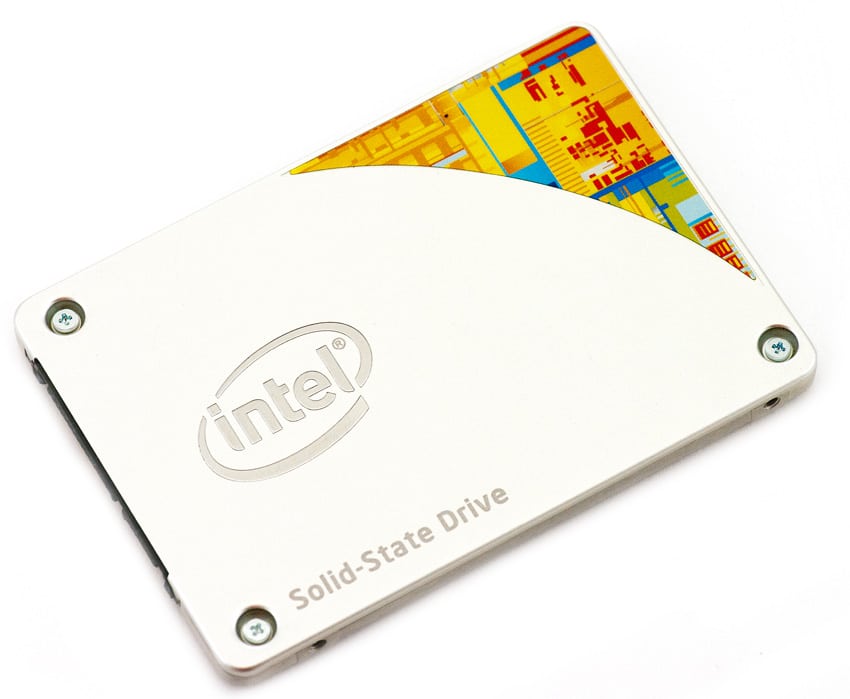
Every Intel 530 SSD is quoted to have a maximum read speed of 540 MB/s and a write speed of 490 MB/s. With those performance numbers– a tad lower than other SandForce-based SSDs–it’s clear that Intel’s new 530 line is catered towards a more mainstream consumer base rather than for the maximum possible transfer rates. Additionally, the maximum 4k random IOPS is 41,000 and 80,000 for reading and writing respectively. The Intel SSD 530 Series also offers key features such as Advanced Encryption Standard (AES) 256-bit Encryption to protect user data, End-to-End Data Protection, and Data Compression to help improve performance and endurance by automatically compressing information sent to the SSD.
The M.2 SSDs, mSATA and 2.5-models all use the Serial ATA 600 interface. The 2.5-inch version comes in 80GB, 120GB, 180GB, 240GB, 360GB and 480GB capacities. The mSATA and M.2 models are limited to in 80GB, 120GB, 180GB and 360GB. All of the Intel 530 SSDs ship with a five-year warranty. We are reviewing the 240GB 2.5” 7mm unit.
Intel SSD 530 SATA Specifications:
- Capacities:
- 80GB
- 120GB
- 180GB
- 240GB
- 360GB
- 480GB
- Performance
- Sustained Sequential Read: up to 540MB/s
- Sustained Sequential Write: up to 490MB/s
- Random 4 KB Reads: up to 41,000 IOPS
- Random 4 KB Writes: up to 80,000 IOPS
- Components:
- Intel 20 nm MLC NAND Flash Memory
- SandForce SF-2200 Controller
- AES 256-bit Encryption
- Form Factors: 2.5-inch
- Thickness: 7 mm
- Weight: Up to 78 grams
- Operating: 0C to 70C
- Uncorrectable Bit Error Rate (UBER): <1 sector per 1016 bits read
- Mean Time Between Failure (MTBF): 1,200,000 hours
- Warranty: 5 Years
Design and Build
One of the small things about the new 530 series is that it appears Intel is now taking the design of its consumer-branded SSDs up a notch. As such, the Intel 530 240GB has a very nice, modern look to it in terms of design with its silver colored all metal enclosure, with a dash of color with the faux circuit board sticker.
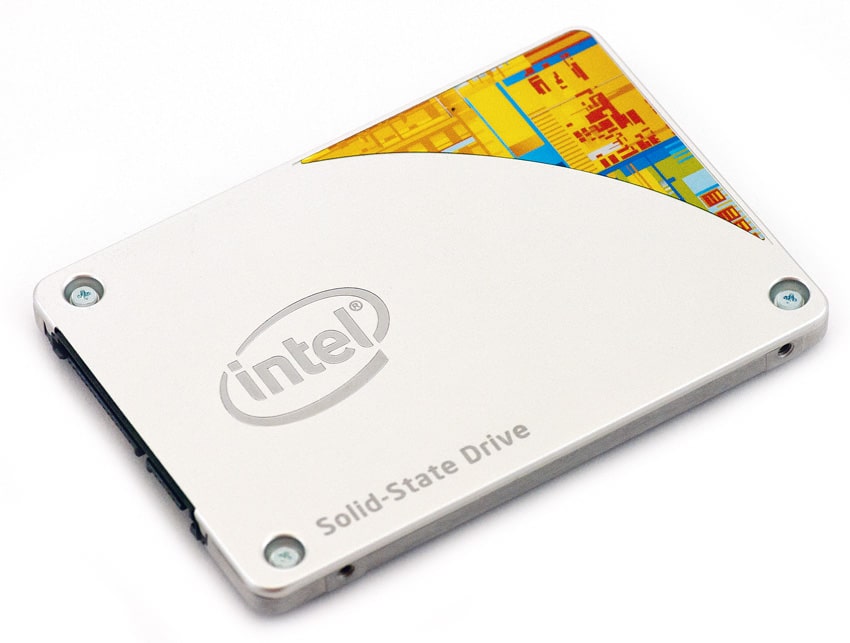
Similar to previous Intel SSDs sharing the same case design, its 7mm z-height makes it compatible with thinner notebook designs and other systems needing the smaller form factor.
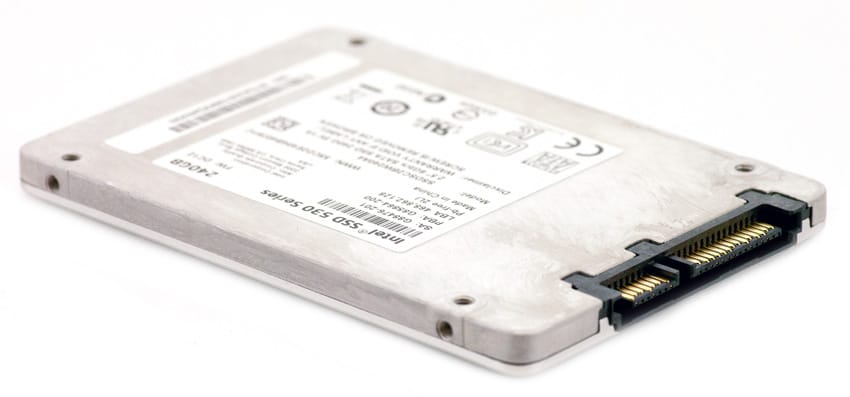
Looking at the connectors, we see the standard power and Serial ATA connectors. This drive is SATA3 (6G) and is backwards compatible with SATA2 as well; however, the bandwidth limitation would be capped to approximately 270 MB/sec with SATA2, which is still much faster than HDDs.
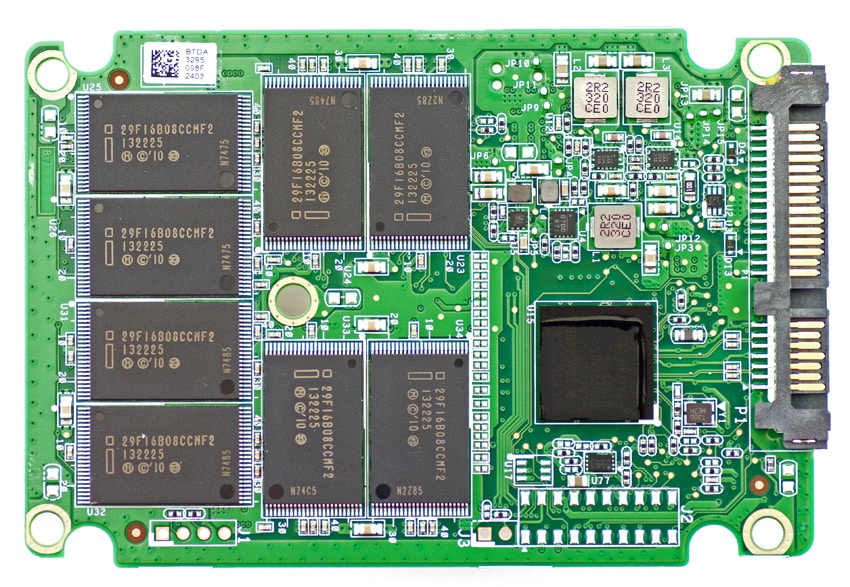
Under the hood, we will see that the Intel 530 makes use of Intel (Micron) 20nm MLC written NAND as well as a cross Intel/LSI-branded SandForce controller.
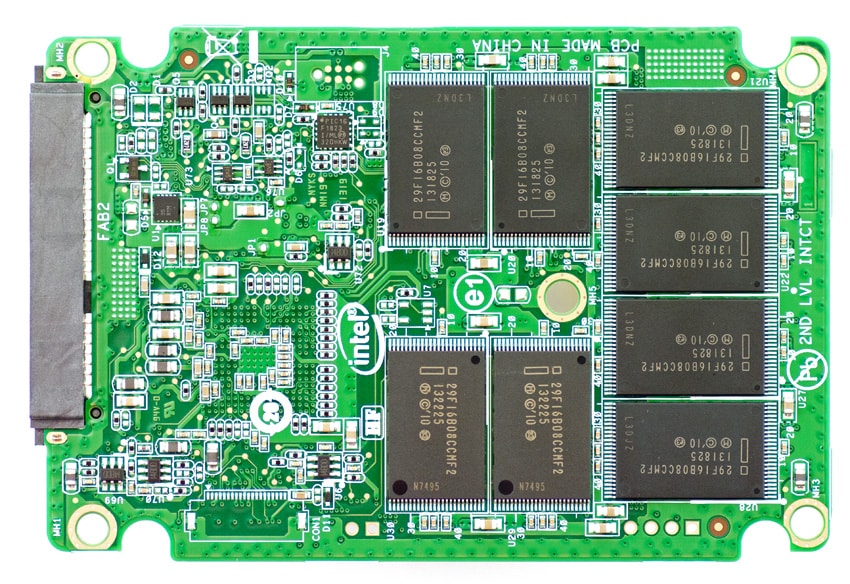
The bottom side of the circuit board includes 8 additional NAND packages, making the total sixteen.
Consumer Synthetic Benchmarks
All consumer SSD benchmarks are conducted with the mid-range StorageReview Consumer Testing Platform. The comparables used for the review below include:
- Crucial M500 (480GB, Marvell 9187, Micron 20nm MLC NAND, SATA)
- OCZ Vector (256GB, Indilinx IDX500M00-BC Barefoot 3, 25nm MLC NAND, SATA)
- Samsung SSD 840 EVO (250GB, 400MHz Samsung 3-core MCX controller, Samsung 1x nm Toggle NAND Flash, SATA)
- Seagate 600 SSD (120GB, Link-a-Media LM87800, 19nm MLC NAND, SATA)
- OCZ Vertex 150 SSD (240GB, Indilinx Barefoot 3 BF3-M10, 19nm MLC NAND, SATA)
- Corsair Force LS (240GB, 19nm Toshiba MLC, SATA)
All IOMeter figures are represented as binary figures for MB/s speeds.
In our first test measuring 2MB sequential performance, the Intel 530 SSD measured 498.8MB/s read and 459.5MB/s write repeating, while the random benchmark measured 492.9MB/s read and 315.3MB/s write. Its predecessor, the Intel SSD 520, had somewhat similar results scoring 495.4MB/s and 462.0MB/s in the repeating read and write columns respectively while hitting 486.1MB/s and 289.7MB/s in the random read and write columns respectively.
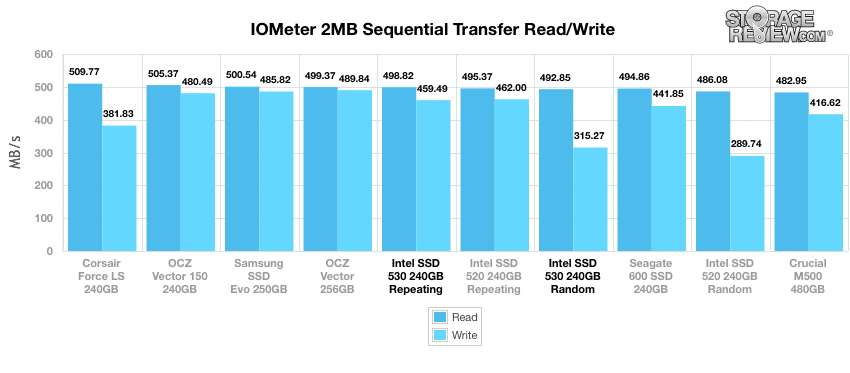
In our next test looking at 2MB random transfer performance, the Intel 530 SSD measured 495.6MB/s read and 459.3MB/s write repeating and 486.8MB/s read and 315.9MB/s write random.
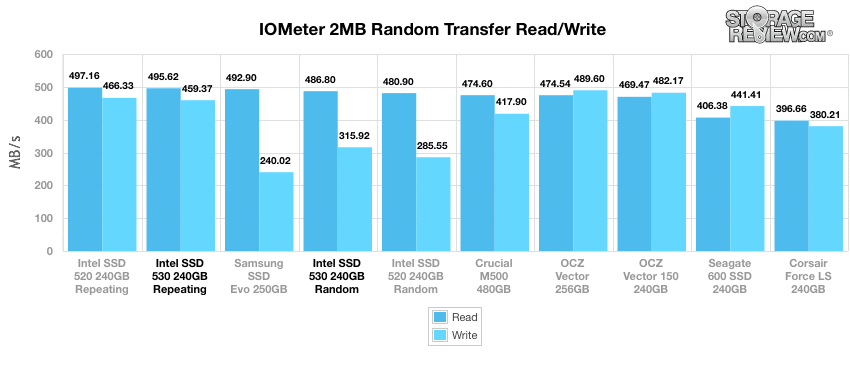
Switching to smaller 4K random transfers, the Intel 530 SSD measured 7,876 IOPS read activity and 18,934 IOPS write activity in the repeating column and 7,421 IOPS read and 19,116 IOPS in the random column, which ranked last and upper middle of the pack respectively. Its SSD 520 brethren performed slightly better in write performance, with speeds of 20473 IOPS and 19682, repeating and random respectively.
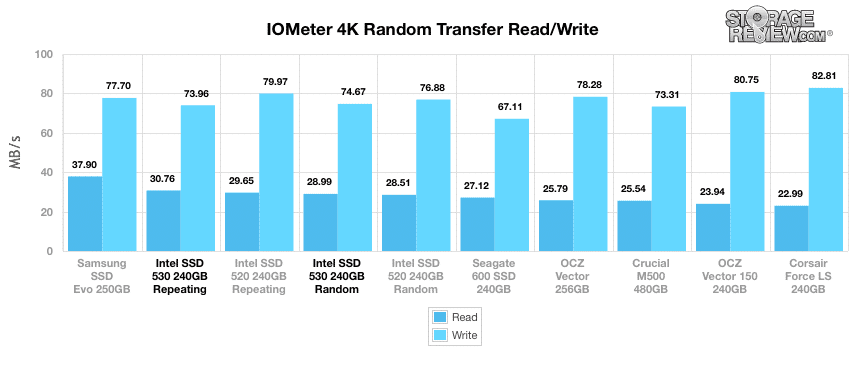
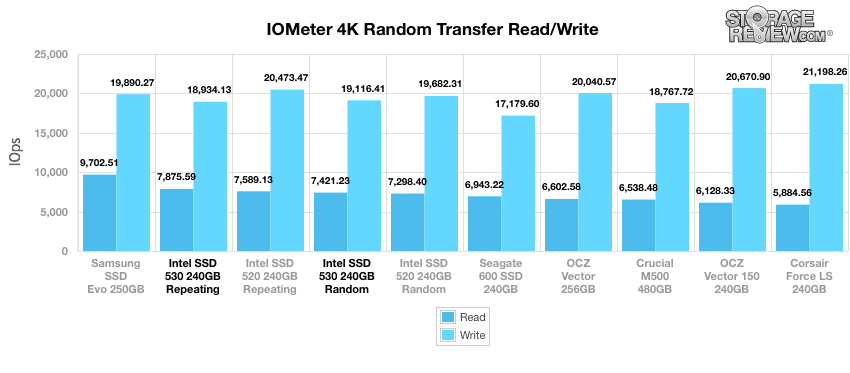
In our next test, we shift to a smaller 4k random workload with 100% read activity that scales from 1QD to 64QD. In this setting, the Intel 530 SSD scaled from 7,640 IOPS up to 62,943 IOPS repeating and 7,290 IOPS and 55,693 IOPS random.
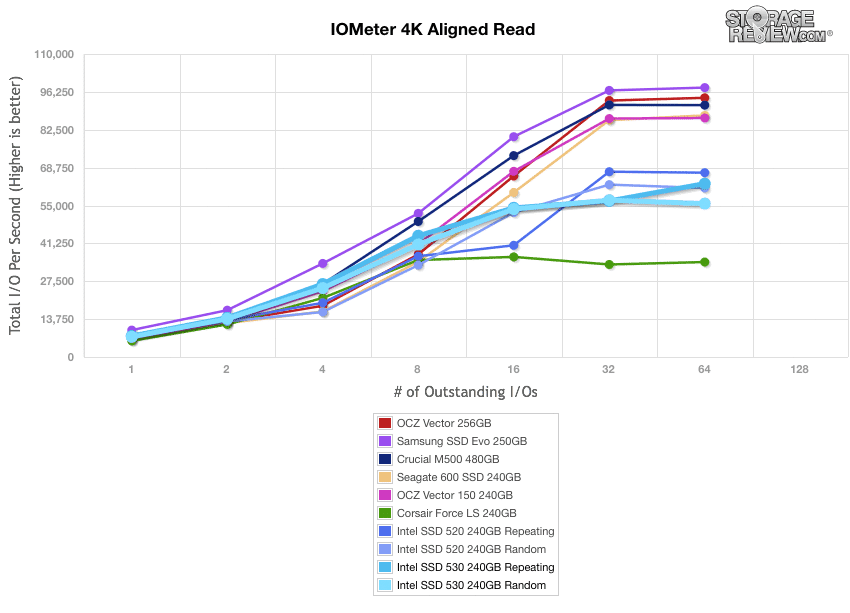
Shifting focus to write activity, the Intel SSD 530 still maintained its struggle, measuring 18,987 IOPS at QD1 and peaking at just over 76,659 IOPS at QD64 repeating and 18,781 IOPS at QD1 and 62,093 IOPS at QD64 random.
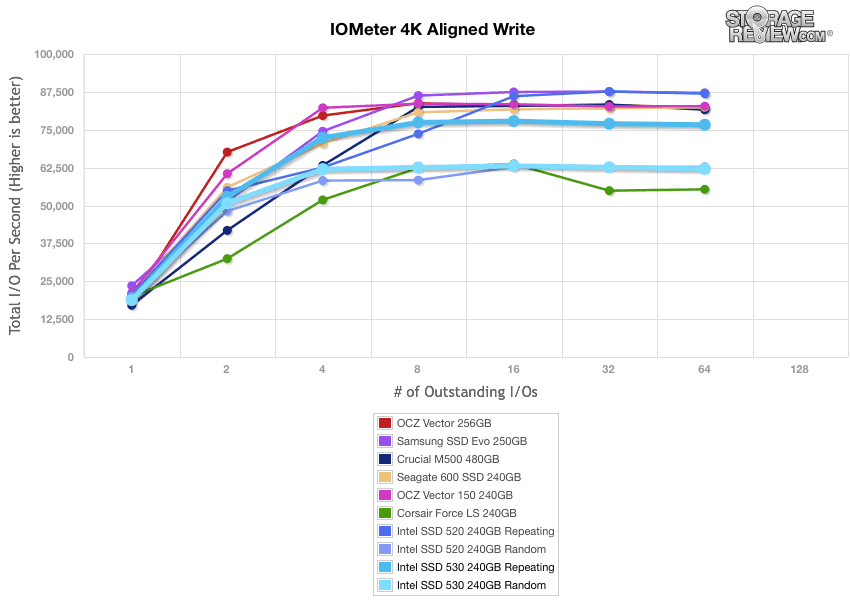
Comparing average write latency between each mainstream consumer SSD, the Intel 530 SSD ranked at the bottom of the pack with an average latency of 0.052ms and a peak latency of 10.00ms in the repeating column. As far as random goes, it performed virtually the same with 0.052ms average latency and peaking at 10.28ms.
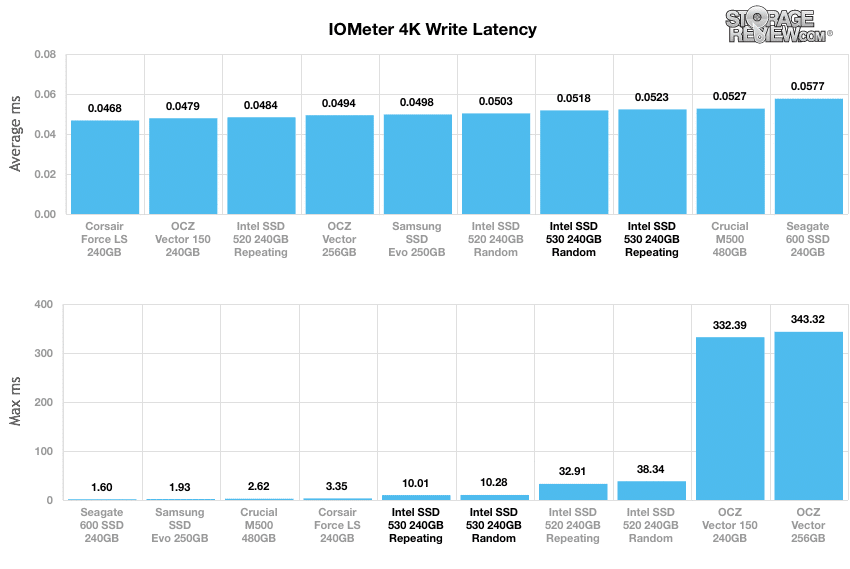
Our last series of synthetic benchmarks compare the hard drives in a series of server mixed-workloads with a queue depth of ranging from 1 to 128. Each of our server profile tests has a strong preference towards read activity, ranging from 67% read with our database profile to 100% read in our web server profile. In all of our mixed workloads, the Intel SSD 530 ranked near the middle of the pack.
The first is our database profile; with a 67% read and 33% write workload mix primarily centered on 8K transfer sizes. In the test, the Intel SSD 530 performed near the top of the pack by Q128 in the repeating column, though it did come up well short in the random column. Interesting enough, the Intel SSD 520 outperformed its successor.
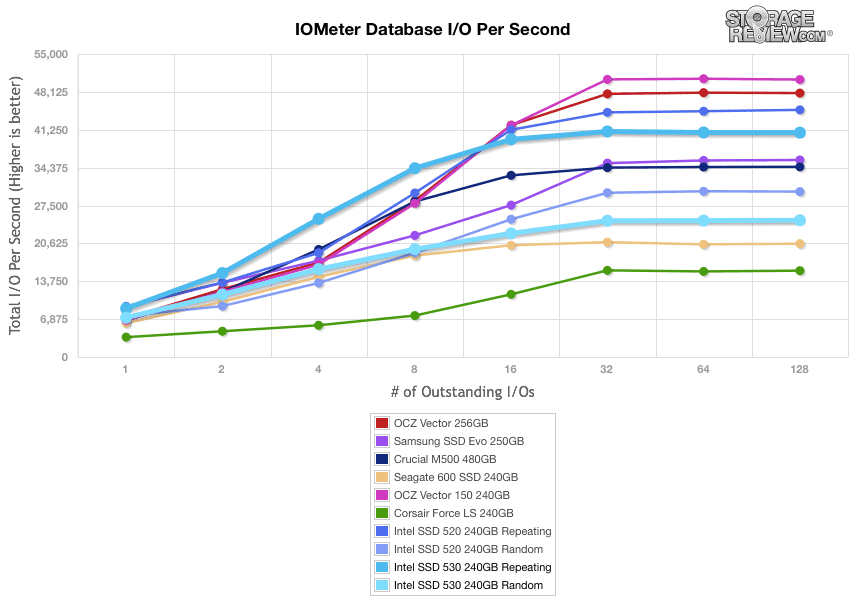
The next profile looks at a file server, with 80% read and 20% write workload spread out over multiple transfer sizes ranging from 512-byte to 64KB. The Intel SSD 530 delivered QD1 repeating throughput near the top of the pack and it stayed that way by Q128. Again, random throughput fell short by QD128.
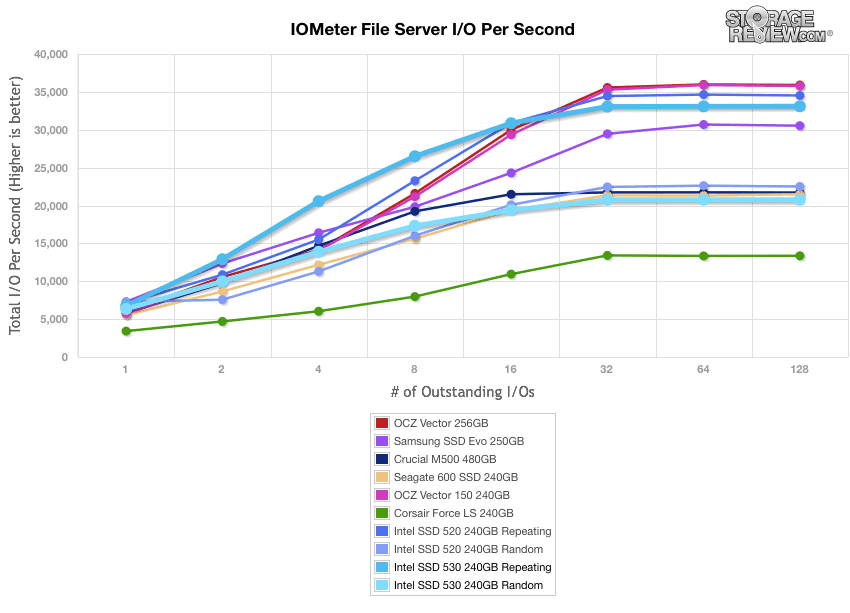
Our web server profile is read-only with a spread of transfer sizes from 512-byte to 512KB. The Intel SSD 530 drive provided performance in the lower middle.
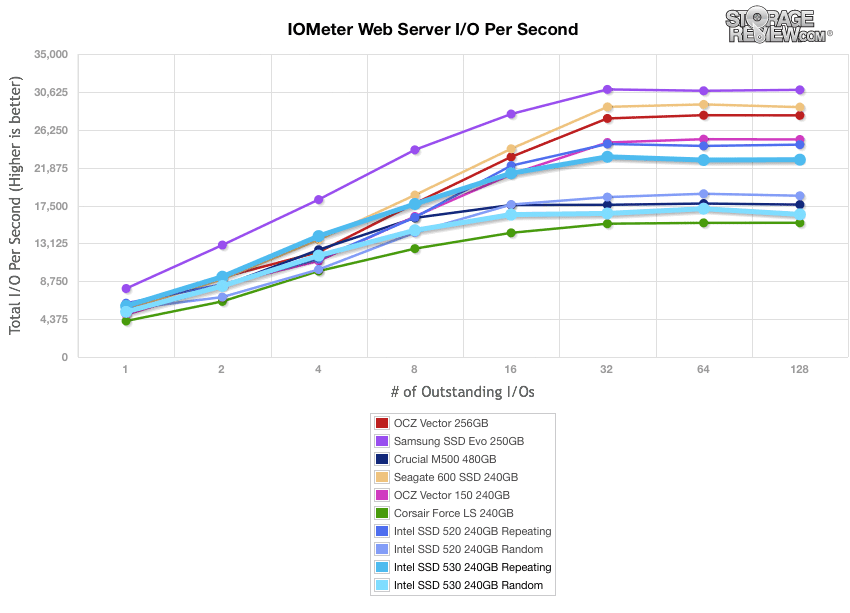
The last profile looks at workstation activity, with a 20% write and 80% read mixture using 8K transfers. In QD1, the Intel SSD 530 drive started at the top with 8,736 IOPS mark but ended up at near the middle of the leader board by Q128.
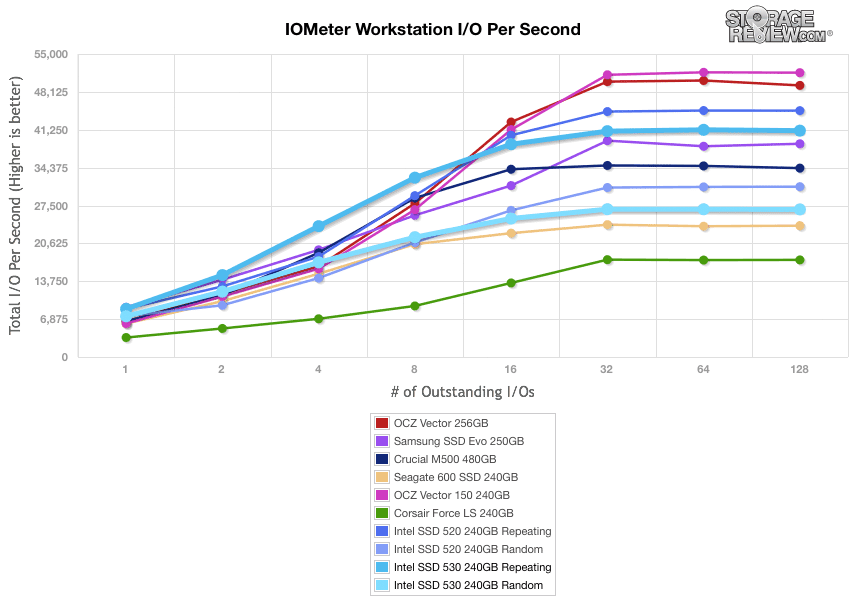
Consumer Real-World Benchmarks
For the average consumer, trying to translate random 4K write speeds into an everyday situation is pretty difficult. It helps when comparing drives in every setting possible, but it doesn't exactly work out into faster everyday usage or better game loading times. For this reason we turned to our StorageMark 2010 traces, which include HTPC, Productivity, and Gaming traces to help readers find out how a drive might rank under these conditions.
The first real-life test is our HTPC scenario. In this test we include: playing one 720P HD movie in Media Player Classic, one 480P SD movie playing in VLC, three movies downloading simultaneously through iTunes, and one 1080i HDTV stream being recorded through Windows Media Center over a 15 minute period. Higher IOps and MB/s rates with lower latency times are preferred. In this trace we recorded 2,986MB being written to the drive and 1,924MB being read.
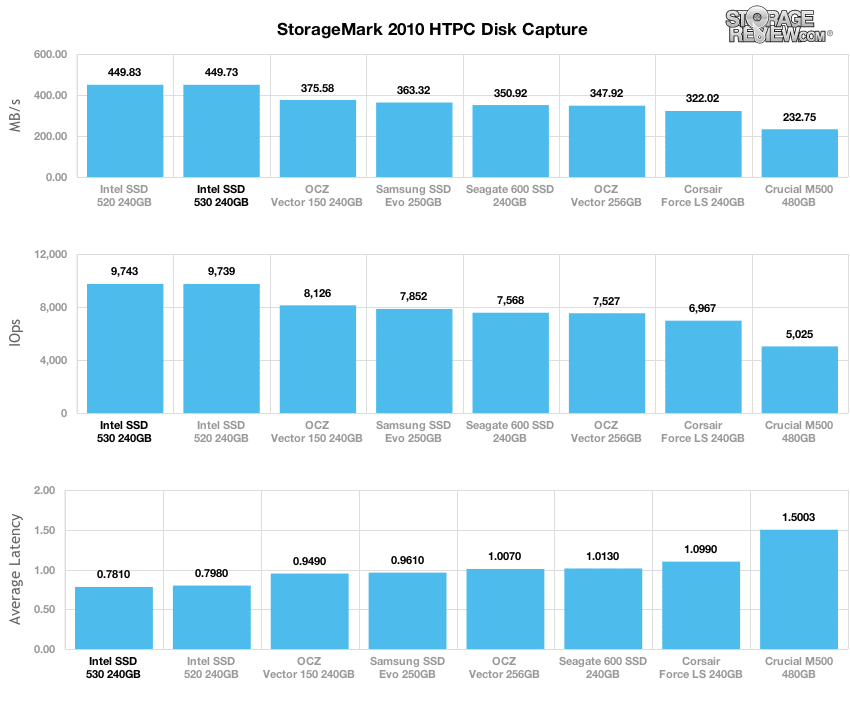
In our HTPC profile, the Intel SSD 530 and 520 out-performed all of the comparables with respective IOPS scores of 9,743 and 9,739. Additionally, they clocked in at 449.8MB/s and 449.9MB/s–just behind the Vector 150–with an average latency of 0.79ms and 0.80ms respectively.
Our second real-life test covers disk activity in a productivity scenario. For all intents and purposes this test shows drive performance under normal daily activity for most users. This test includes: a three hour period operating in an office productivity environment with 32-bit Vista running Outlook 2007 connected to an Exchange server, web browsing using Chrome and IE8, editing files within Office 2007, viewing PDFs in Adobe Reader, and an hour of local music playback with two hours of additional online music via Pandora. In this trace we recorded 4,830MB being written to the drive and 2,758MB being read.
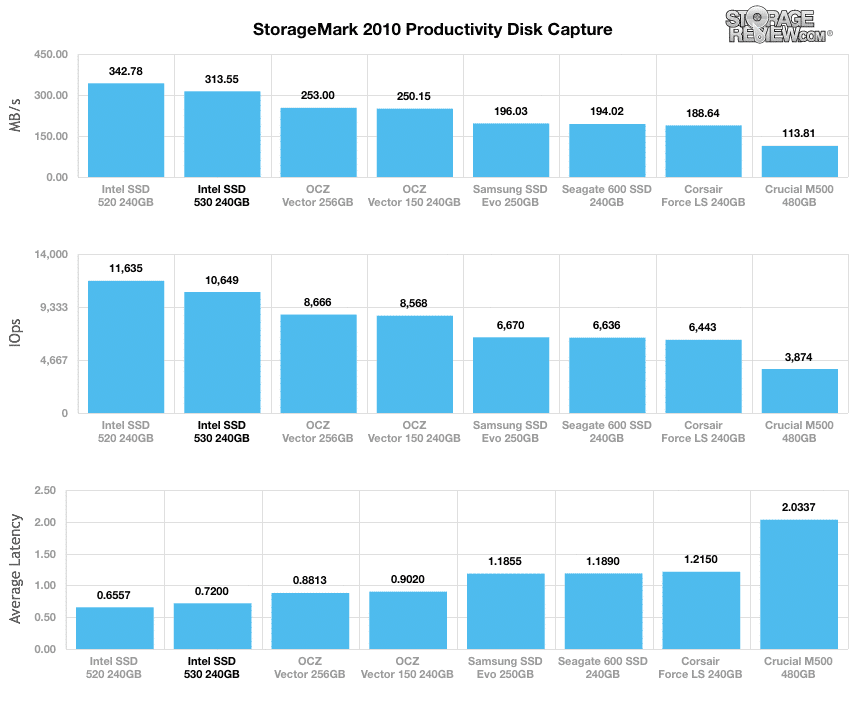
In our Productivity trace, the Intel SSD 530 and 520 continued its dominance, registering 10,649 IOPS and 11,635 IOPS respectively, taking the top spot by a significant margin.
Our third real-life test covers disk activity in a gaming environment. Unlike the HTPC or Productivity trace, this one relies heavily on the read performance of a drive. To give a simple breakdown of read/write percentages, the HTPC test is 64% write, 36% read, the Productivity test is 59% write and 41% read, while the gaming trace is 6% write and 94% read. The test consists of a Windows 7 Ultimate 64-bit system pre-configured with Steam, with Grand Theft Auto 4, Left 4 Dead 2, and Mass Effect 2 already downloaded and installed. The trace captures the heavy read activity of each game loading from the start, as well as textures as the game progresses. In this trace we recorded 426MB being written to the drive and 7,235MB being read.
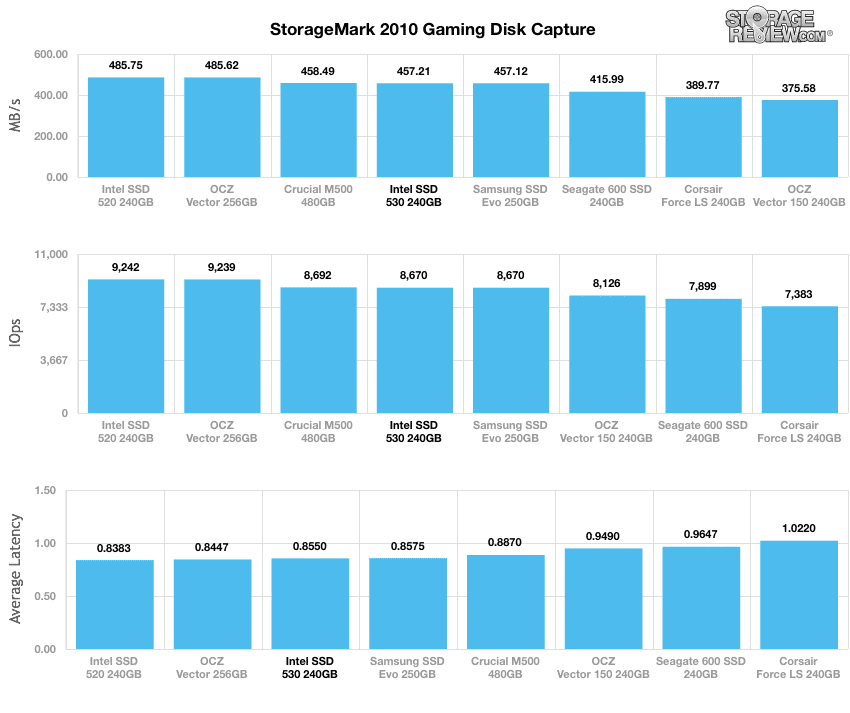
In our read-intensive Gaming trace, the Intel SSD 530 produced a respectable 457.2MB, right at the top of the pack.
Power Consumption
As SSDs spend much of their time in the idle state, low idle power consumption is a key factor in overall SSD power management.

In our tests, we measured great idle power consumption from the Intel SSD 530 at 0.35W. During sequential write activity and incompressible write it scored 2.10W and 4.33W respectively. The Intel SSD 520 unit had higher idle power consumption at 0.81W.
Conclusion
The Intel SSD 530 line is a progressive addition to Intel’s family of SSDs and the successor to their 520 SSDs. One of the more attractive things about the 530 is that it ships in a plethora of mid-range capacities in several form factors including 80GB, 120GB, 240GB, 360GB, and 480GB. Of course the drive is largely a good performer as well, boasting real-world test throughput that is very impressive from a 240GB drive; it will be interesting to see how the higher capacities stack up in their different form factors. Additionally, consumers will receive a five year warranty for the drives which is more or less the top of the market for client SSDs.
From a performance perspective, the Intel SSD 530 is highlighted by its strong performance in our real-world workloads, ranking very well in our HTPC and Productivity traces, while in at the middle of the pack in Gaming. Measuring single workloads, the Intel drives were mid to lower performers in 2MB sequential read speeds and remained that way in 4K random write speeds. Looking at mixed workload performance in our server profiles, the Intel 530 ranked middle of the pack, constantly trailing the 520 it replaces. Overall, the Intel SSD 530 proved itself to be a strong competitor in many of our consumer-focused workloads compared to other top-performing consumer SSDs.
Pros
- Strong performance in real-world workloads
- Competitive in sequential performance and random mixed workloads
Cons
- Saw a drop in performance in mixed workloads compared to the SSD 520 it replaces
- Power consumption under load increased compared to 520
Bottom Line
With its top-tier real-world performance and affordable price point, the 530 is a worthy addition of Intel's line of SSDs. In addition to its five-year warranty and record of reliability, the Intel SSD 530 offers a well rounded feature set for mainstream consumers.
Intel SSD 530 at Amazon




 Amazon
Amazon